I have been, or can be if you click on a link and make a purchase, compensated via a cash payment, gift, or something else of value for writing this post. As an Amazon Associate, I earn from qualifying purchases. Please read my full Affiliate Disclosure for more information.
Designing a kids’ room is more than just choosing colors and furniture—it’s about creating a magical space where imagination and functionality collide. Kids’ room ideas are especially popular because parents want to foster creativity while keeping the space practical and safe for their little ones.
In this article, you’ll find a delightful mix of ideas that combine fun, comfort, and practicality, ensuring your child’s room is both inspiring and organized. From playful themes to clever storage solutions, these ideas will help you craft a space that your kids will love to grow and play in, making every inch count for both style and function.
1. Creative Wall Murals with Removable Stickers for Instant Playfulness
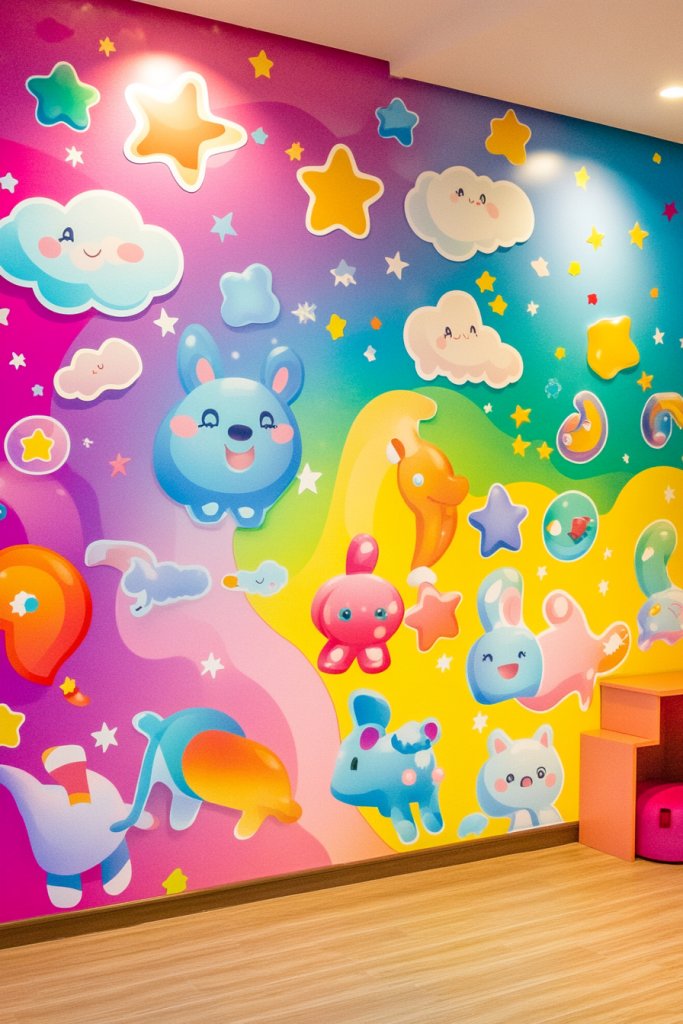
Kids often get bored quickly, and parents struggle to keep their rooms lively and engaging without constant redecorating. A dull wall can make a space feel uninspired and monotonous. Everyone wants a room that sparks imagination but also adapts as interests change. Finding an easy way to refresh the vibe without a huge mess or expense is the real challenge.
Imagine a wall transformed into a vibrant jungle scene with removable stickers of animals and trees. The bright colors pop against neutral walls, creating a dynamic backdrop for play or quiet time. When your child’s interests shift, peel off the old stickers and replace them with new themes—like outer space or underwater worlds. The textures are smooth, and the images are lively, making every wall a canvas of adventure.
Choose murals that match your kid’s favorite themes, from fairy tales to sports. For small rooms, vertical murals can make the space seem taller and more open. Seasonal themes like snowflakes or flowers can rotate for a fresh look. You can also opt for black-and-white sketches for a more subtle, sophisticated vibe suitable for older children.
Start by selecting high-quality, removable stickers or decals designed for walls. Measure the area to ensure the design fits perfectly. Clean the wall surface thoroughly to avoid bubbles or peeling. Apply the stickers carefully, smoothing out air bubbles with a soft cloth. When it’s time for a change, gently peel off the decals without damaging the paint. For more intricate murals, consider using stencils or wall decals with easy peel features.
Add personal touches by including your child’s name or favorite characters within the mural. Use metallic or glow-in-the-dark stickers for extra fun at night. Incorporate textured elements like fabric accents or 3D stickers for tactile engagement. Customizing the color palette to match existing decor makes the mural feel seamless and intentional.
Creating a playful wall can boost your child’s creativity and sense of ownership. It turns their room into a personal gallery of their dreams. Plus, switching out stickers keeps the environment fresh without a full overhaul. You’ll feel proud knowing you can craft a space that grows with them—no expensive redesigns needed.
2. Multi-Functional Loft Beds with Built-In Storage Solutions
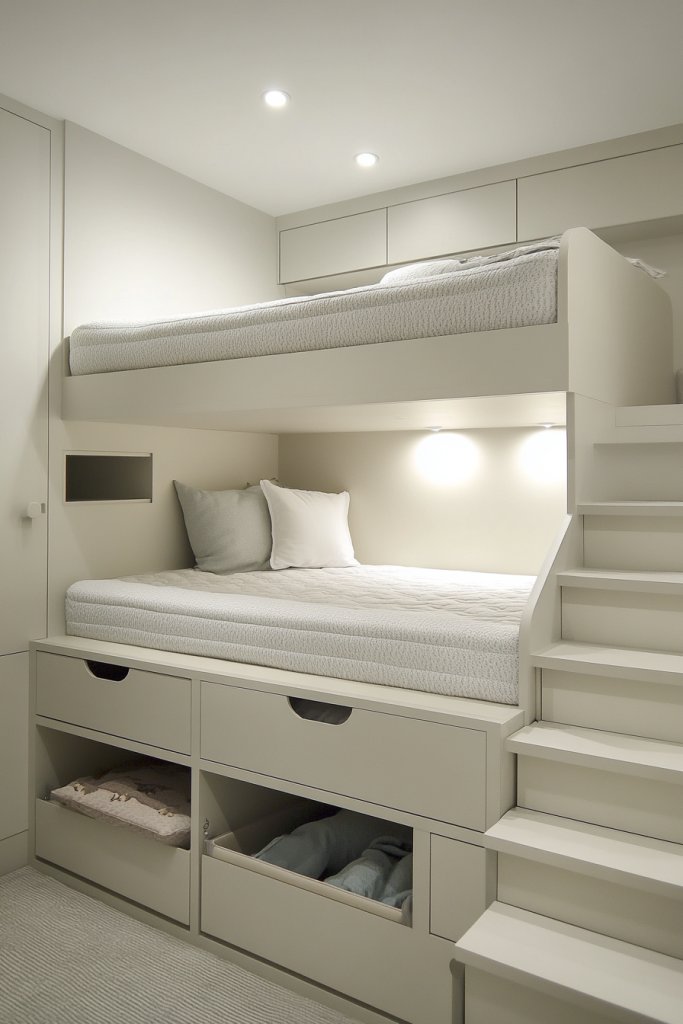
Small bedrooms often leave kids feeling cramped and cluttered, making it hard to find space for everything. Parents want furniture that maximizes square footage while still being fun and kid-friendly. Creating a cozy sleeping nook that also offers storage can solve multiple problems at once. Who says you can’t have both style and practicality?
Picture a sleek loft bed with a sturdy frame, tucked into a corner of the room. Underneath, built-in drawers, shelves, and a small desk turn wasted space into a functional zone. The bed itself is cushioned with colorful bedding, while the storage units are painted in cheerful shades. The overall look is modern yet playful, perfect for a kid who loves to organize and play.
Loft beds come in various styles—some with open shelving, others with closed cabinets. For smaller rooms, opt for a compact design with integrated stairs or ladders that include hidden compartments. You can also customize with themes like space explorers or princess castles. During different seasons, add cozy textiles or decorative elements to match holiday moods.
Choose a sturdy, safety-approved frame that fits your room dimensions. Measure the space carefully to ensure enough clearance. Install the bed securely, following manufacturer instructions, and anchor it to the wall if needed. Underneath, set up storage bins, baskets, or a small desk with organizational accessories. Use labels or color-coding to make tidying easier for your kid. Regularly check for wear and tighten bolts to maintain safety.
Add decals or themed accessories to the bed frame for personality. Use colorful storage bins that coordinate with your child’s favorite hues. Incorporate a cozy reading nook or a mini play area beneath the loft. Personal touches like a string of LED lights or a soft blanket can make the space inviting and unique.
A loft bed with built-in storage transforms a cluttered room into a fun, organized retreat. It encourages your child to take responsibility for tidying up while enjoying a cool, elevated sleeping space. This versatile setup adapts as they grow, making it a smart investment in both comfort and function.
3. Colorful Pegboard Organizers for Easy Toy and Art Storage
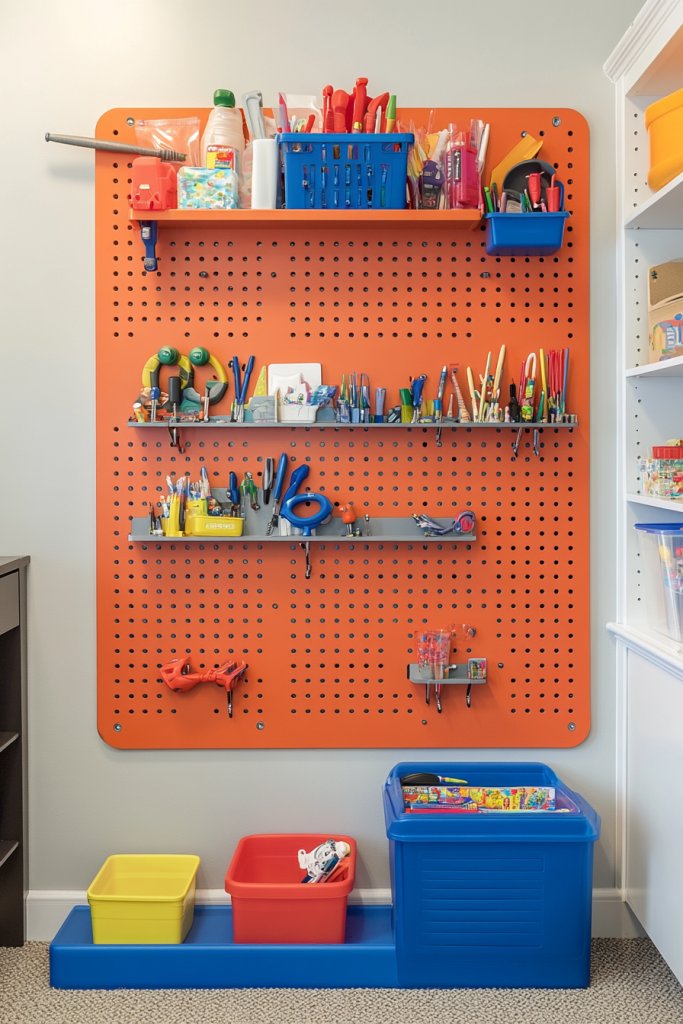
Kids tend to have more toys and art supplies than places to store them, leading to chaos and frustration. Parents want a simple, accessible solution that keeps everything tidy and within reach. A cluttered room not only looks messy but also makes clean-up a nightmare. The goal? Organize with style, without sacrificing fun.
Imagine a bright, cheerful pegboard mounted on the wall, painted in a bold color that matches the room’s theme. Hooks and baskets hang from the pegs, holding crayons, scissors, and small toys. The arrangement is flexible, letting your kid customize the layout as they see fit. The open design makes it easy to grab and put away items, turning tidying into a game.
Choose pegboards in different colors or materials—wood, metal, or plastic—to match your decor. For small items, add small bins or clip-on shelves; for larger toys, use hooks or baskets. Change the layout seasonally by swapping accessories or adding decorative elements like stickers or decals. Mount at a height suitable for your child’s reach to foster independence.
Start by selecting a sturdy pegboard that fits your space. Install it securely on a wall away from high-traffic areas. Organize supplies into small containers or hooks, grouping similar items together for easy access. Use labels or color codes for quick identification. Regularly review and refresh the layout to keep it functional and fun. Incorporate adjustable hooks for flexibility as your child’s collection grows.
Encourage your child to decorate the pegboard with their favorite stickers or drawings. Mix in themed baskets or containers that reflect their interests, like dinosaurs or princesses. Consider adding a small chalkboard section for notes or doodles. Use different hook sizes to create a dynamic, playful look that evolves with their changing tastes.
A colorful pegboard turns storage into a creative activity, empowering your kid to stay organized. It makes clean-up fast and fun, reducing tantrums over messes. Plus, it teaches valuable skills in categorizing and caring for their belongings—building confidence and independence in the process.
4. Cozy Reading Nooks with Cushions and String Lights
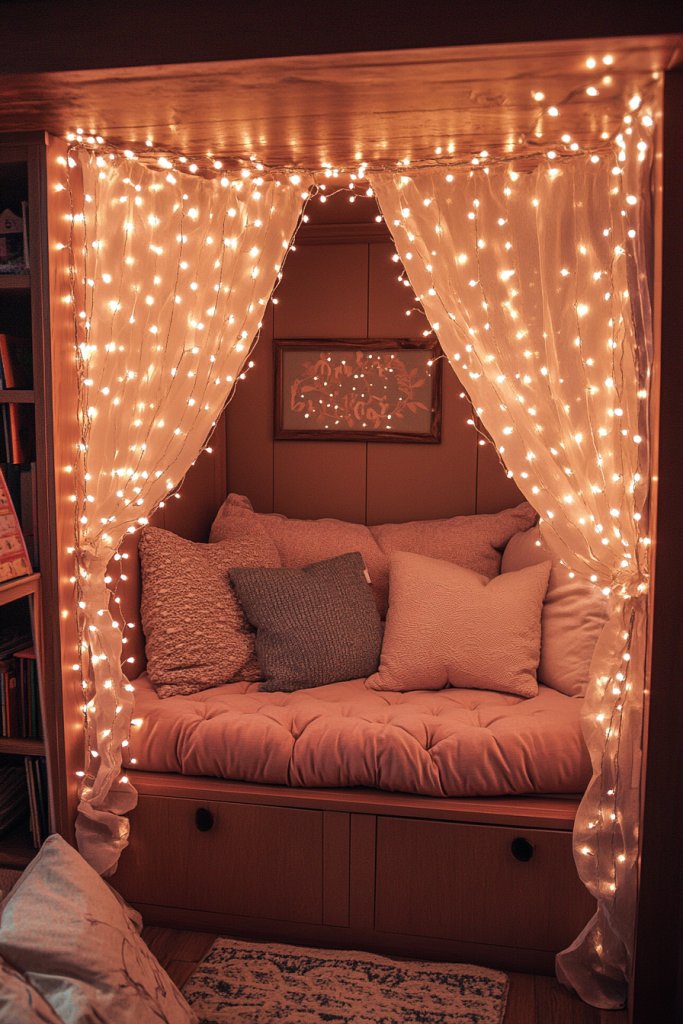
Kids love having a special spot just for reading, but many rooms lack a dedicated cozy corner. Creating a little retreat encourages a lifelong love of books and quiet time. Without a comfortable space, reading can feel like a chore rather than a pleasure. Parents want a nook that’s inviting, practical, and fun.
Visualize a small corner with a plush floor cushion surrounded by soft blankets. String lights hang overhead, casting a gentle glow that makes reading time magical. A small bookshelf nearby holds their favorite stories, easily accessible for little hands. The space is inviting, with textured pillows and a variety of tactile fabrics that create a warm, welcoming atmosphere.
You can customize the nook with themed decor—detective hats, fairy wings, or animal plushies—to make it more personal. Use different textiles like velvet, fleece, or woven fabrics to suit seasonal changes or preferences. For small rooms, tuck the nook into a corner or under a window for maximum space efficiency. Add a small side table or a step stool for older kids who want to read standing or sit cross-legged.
Choose a comfortable cushion or a low bench as the base. Cover it with removable, washable fabric for easy cleaning. Hang string lights with low-wattage bulbs or LED options for safety. Place a small bookshelf or wall-mounted shelves nearby, filled with books your child loves. Incorporate decorative elements like themed cushions or tactile rugs to elevate comfort. Regularly rotate books to keep their interest piqued.
Add personal touches such as a custom name sign or framed artwork above the nook. Let your child pick textiles that match their favorite colors or characters. Incorporate a small basket for plush toys or a mini lantern for bedtime stories. These little details make the space truly theirs and encourage regular reading habits.
A cozy reading nook turns a boring corner into a magical escape that promotes literacy and relaxation. It’s a space they can call their own, fostering independence and confidence. Over time, it becomes a sanctuary for quiet moments and imagination, enriching their growth and love for books.
5. Under-Desk Play Zones with Cushioned Mats and Storage Bins
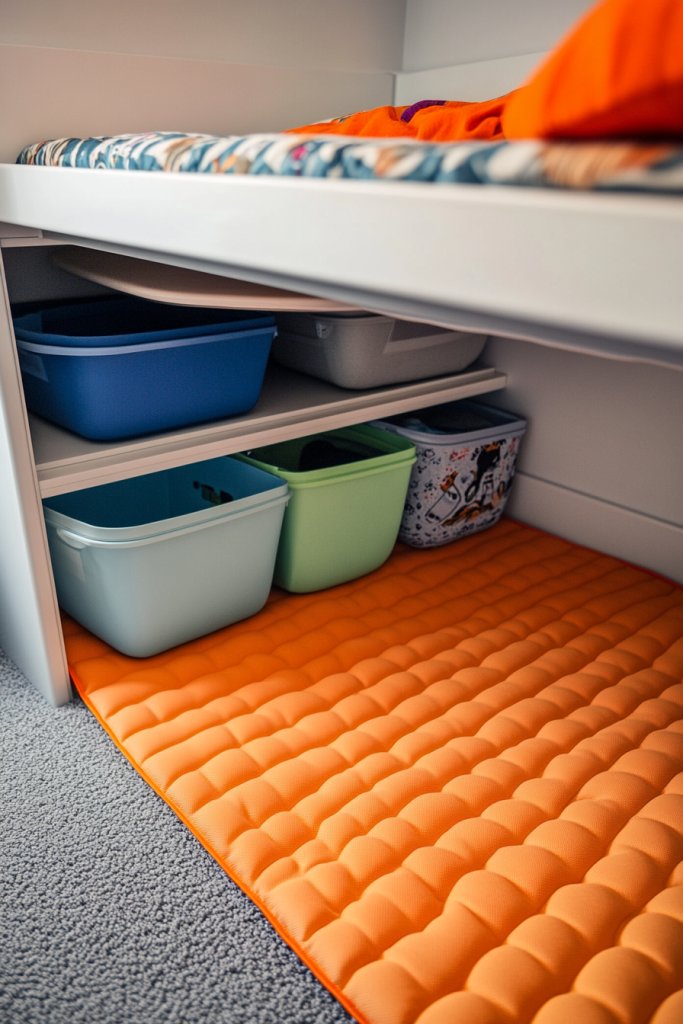
Small rooms often struggle with finding enough space for play and study without feeling cluttered. Parents want a dedicated zone where kids can be creative without taking over the entire room. An under-desk area is perfect for making use of otherwise wasted space. But how do you keep it organized and inviting?
Envision a compact nook beneath a child’s desk, filled with a colorful cushioned mat. Small storage bins hold art supplies, building blocks, or figurines, all within arm’s reach. The space feels like a secret hideaway, with a cheerful vibe created by playful patterns on the mats and containers. When kids sit or kneel here, it’s a cozy, inviting zone for hours of fun.
Choose mats in bright, cheerful colors or fun shapes like stars or circles to add personality. Use stackable bins or soft fabric drawers for easy access and quick clean-up. For different seasons, swap out textiles or add themed covers—think holiday patterns or favorite characters. Keep the area clutter-free by establishing a simple system of labels and designated zones.
Start by selecting a cushioned mat that’s comfortable and easy to clean. Arrange storage bins that fit snugly beneath the desk or attach to the side panels. Use clear containers so children can see their toys, encouraging independence. Teach them to put items back after play, making tidying effortless. Regularly review the contents to remove unused items and refresh the space. Consider adding a small, portable caddy for art supplies for even more convenience.
Let your child decorate the storage bins with stickers or labels featuring their favorite themes. Incorporate a small bulletin board or chalkboard above the area for notes or doodles. Use textured cushions or a soft blanket to make the space even more inviting. Personal touches turn this functional zone into a playful, treasured corner.
A well-organized under-desk play zone fosters independence and responsibility. Kids learn to manage their own space and keep their toys tidy. It’s a clever way to turn small rooms into flexible, multi-use environments that grow with them.
6. Themed Storage Bins and Labels for Easy Clean-Up
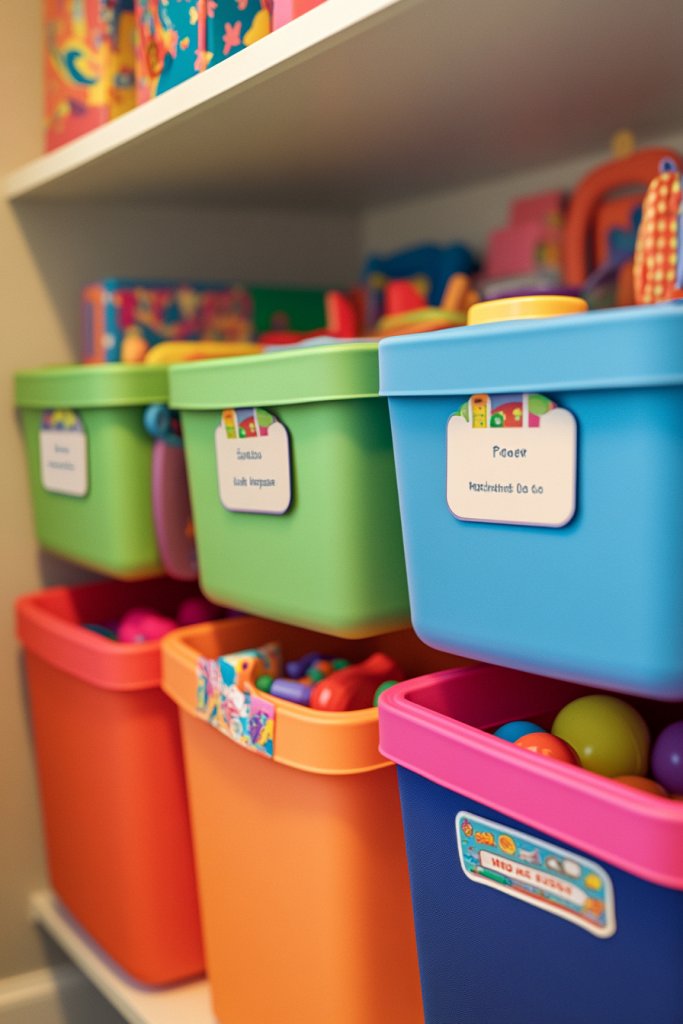
Cleaning up after playtime can feel like a battle, especially when toys are scattered everywhere. Parents want a system that encourages kids to tidy up without constant nagging. The key is making organization intuitive and visually appealing so children want to participate. But how do you keep it fun and effective?
Picture colorful storage bins with themed stickers—dinosaurs, princesses, or superheroes—on each container. Clear labeling helps children identify where toys go, making clean-up quick and simple. The bins are arranged neatly on shelves or in cubbies, creating a cheerful, organized display. Kids feel proud when they see their room look tidy, almost like a mini toy store.
Select bins in various sizes and colors to match the room’s decor and your child’s preferences. Use custom labels with their handwriting or fun fonts to personalize each bin. For seasonal changes, swap out labels or add new themes. Incorporate stacking options or modular units to adapt as their collection grows. You can also add small handles or grips for easy carrying.
Start by choosing durable, easy-to-clean bins in bright colors or themed designs. Label each with words or pictures to indicate contents. Place them on open shelves or inside cubbies for quick access. Teach your child to put items back after using them, reinforcing the habit of organization. Regularly review and rotate the contents to keep things current. Using a consistent system makes clean-up less of a chore and more of a game.
Encourage your child to decorate their labels with drawings or stickers. Use themed containers that reflect their current interests, like dinosaurs or fairies. Add a reward system for keeping their space tidy, such as stickers or points. Make labels removable so they can update themes as they change.
A personalized storage system builds responsibility and pride in your child’s space. It teaches organizational skills early on, making future chores easier. Plus, a tidy room fosters calm and focus, turning cleaning into a positive activity rather than a hassle.
7. Adjustable Desk and Chair Set for Growing Kids
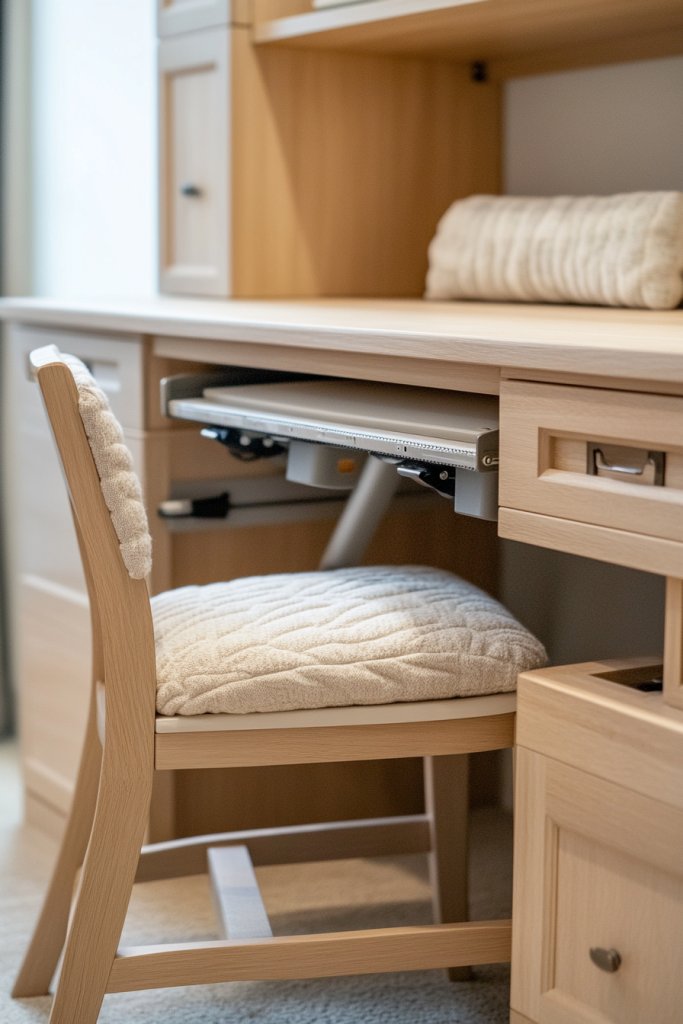
Kids grow fast, and furniture that fits today might be uncomfortable tomorrow. Parents want adjustable desks and chairs that can keep up with their child’s changing height and needs. Investing in ergonomic furniture means fewer postural issues and more comfort during homework or creative time. But finding pieces that truly adapt can be tricky.
Imagine a sleek desk with a height-adjustable tabletop and a matching chair that grows with the child. The desk’s surface can be raised or lowered smoothly, while the chair’s seat height adjusts with a quick twist. The setup is minimalist, with a clean design in neutral tones that fits any room decor. Bright accents on the chair or desk edges add a playful touch, making the workspace inviting.
Choose adjustable furniture with simple mechanisms for easy use. For younger kids, opt for desks with storage drawers and colorful accents; for older kids, sleek, modern designs work best. Incorporate accessories like footrests or ergonomic cushions to enhance comfort. During different seasons, swap out cushions or add decorative elements to match themes. Modular designs also allow for multiple configurations, accommodating different activities.
Select high-quality, adjustable furniture that meets safety standards. Measure your child’s current height and plan for future growth—aim for a desk height that allows elbows to rest comfortably. Install the desk and chair, ensuring stability and smooth adjustment mechanisms. Use a level to check proper alignment and safety. Educate your child on how to adjust the furniture safely as they grow. Add organizational accessories like desk organizers or small shelves for supplies.
Decorate the workspace with their favorite colors, stickers, or themed accessories. Incorporate a corkboard or whiteboard for notes and doodles. Use adjustable lighting options like clip-on lamps for personalized illumination. Let your kid choose desk accessories that reflect their personality, making the space truly theirs. Keep the setup flexible so they can rearrange as interests evolve.
An adjustable workspace fosters independence and responsibility, empowering your child to manage their environment. Proper ergonomics promote good posture, preventing discomfort and future health issues. It sends a message that their comfort and needs matter, boosting confidence. As they grow, the furniture adapts, supporting long-term use and a positive attitude toward learning.
8. Wall-Mounted Art Stations with Easy-to-Clean Surfaces
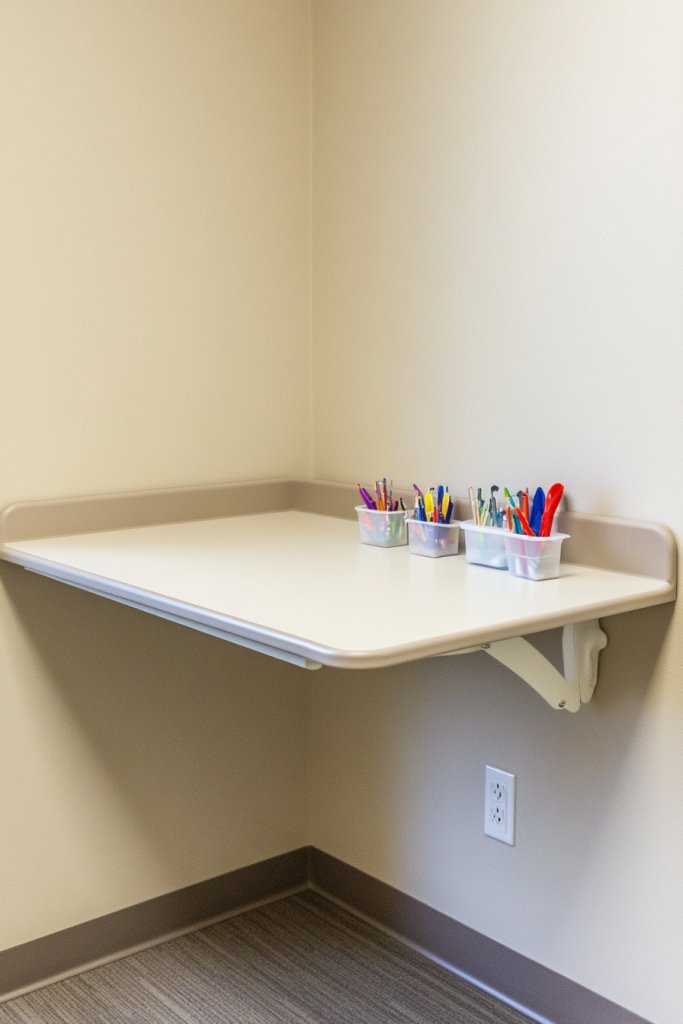
Kids love to express themselves through art, but messes often get in the way of creating freely. Parents want a dedicated art space that’s inspiring yet easy to maintain. A cluttered table or messy floor discourages creativity and can be overwhelming to clean up afterward. The solution? A wall-mounted station designed for mess-free fun.
Visualize a slim wall panel with a wipeable, chalkboard or whiteboard surface. Art supplies hang on hooks or magnetic strips nearby, keeping everything organized. The surface is large enough for drawing, writing, or crafting, with space for quick cleanups. Brightly colored markers or chalk add vibrancy, and a small ledge holds erasers and brushes. The entire setup is sleek and functional, encouraging spontaneous creativity.
Choose surfaces that suit your child’s age and skill level, from chalkboards to magnetic whiteboards. Incorporate clips or containers that attach directly to the wall for easy access. For small spaces, mount the station above a desk or window sill. Seasonal themes can be added with removable decals or border trims. Use different colors for different activities or days of the week to keep it fresh.
Pick a durable, wipeable surface that mounts securely to the wall. Install at a height suitable for your child, ensuring it’s within easy reach. Organize supplies in wall-mounted containers or small baskets attached nearby. Teach your child how to use the station and clean it after each session. Regularly sanitize the surface and replace supplies as needed. Consider adding a small stool or step for taller kids or for adjustable height.
Decorate the border with colorful tape or removable decals that reflect your child’s interests. Let them choose markers, chalks, or accessories in their favorite colors. Incorporate a small corkboard or magnetic strip for displaying their latest masterpieces. Personal touches like a name decal or themed border make the station more inviting. Encourage them to add their own creative touches to the setup.
A wall-mounted art station nurtures creativity and independence, showing kids that their artistic efforts are valued. It keeps mess confined to a single area, making cleanups easier and less stressful. Seeing their artwork proudly displayed or stored motivates continued expression. Plus, it’s a practical way to foster a love for art that can last a lifetime.
9. Floating Shelves for Displaying Favorite Toys and Collectibles
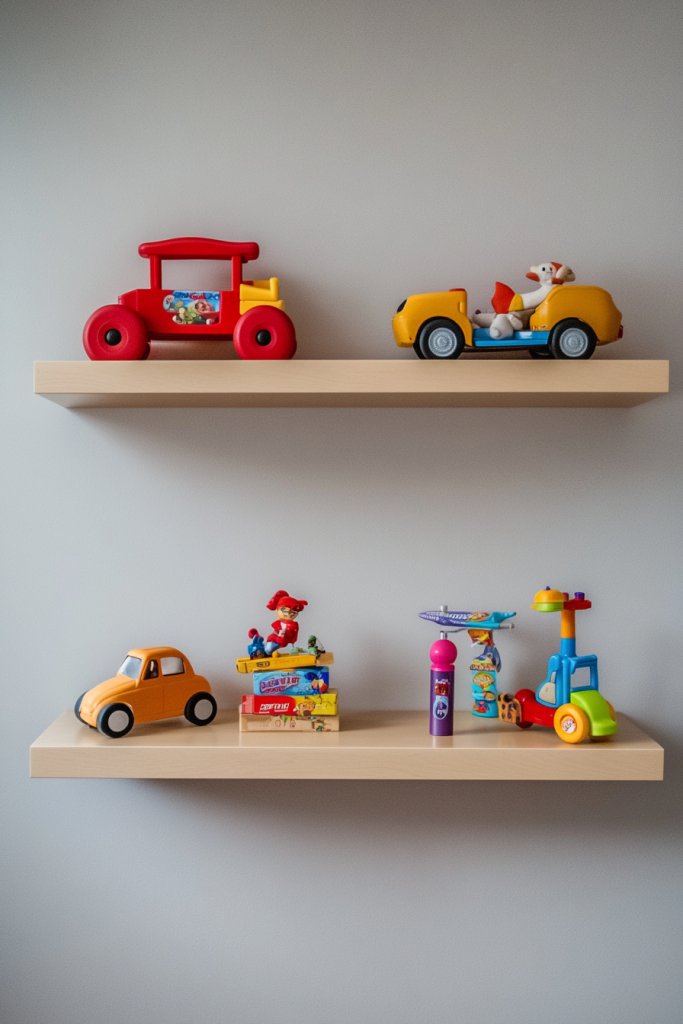
Cluttered surfaces and overflowing toy boxes make a room feel chaotic and uninviting. Kids love showcasing their favorite toys, but without proper display options, they get buried or lost. Parents want a clean, organized look that still highlights those special items. Floating shelves are a stylish, space-saving solution that balances display and tidiness.
Imagine sleek, minimalistic floating shelves mounted along a wall, painted in a neutral tone. Displayed on them are beloved action figures, small sculptures, or framed photos—each carefully curated. The shelves create a layered effect, adding depth and dimension to the room. The setup is modern, with clean lines that make the toys stand out as decorative accents rather than clutter.
Use different lengths and depths of shelves to create visual interest. Mix open shelves with glass-fronted cabinets for a more curated look. Coordinate shelf colors with the room’s palette or go for contrasting shades for a bolder statement. For a theme, add decorative brackets or LED lighting underneath. Adjust the arrangement seasonally by swapping items or adding themed decor.
Select sturdy, wall-mountable floating shelves that can support the weight of toys and collectibles. Install them at varying heights to accommodate different types of items and to create visual interest. Use a level to ensure accurate placement. Arrange the items thoughtfully, balancing sizes and colors. Keep frequently used or prized possessions at eye level for easy access. Regularly dust and rotate the display to keep it fresh.
Encourage your child to help decorate the shelves with themed accessories or small personal items. Use decorative stickers or labels to categorize the displays, making it easier to keep organized. Incorporate small LED puck lights or fairy lights for extra ambiance. Let them choose new collectibles or rotate items to keep the display current and exciting.
Displaying favorite toys on floating shelves turns the room into a showcase of their personality and achievements. It fosters pride and responsibility as they learn to care for their collectibles. An organized display keeps clutter in check and inspires a sense of order and aesthetics. It’s a simple yet effective way to boost their confidence and love for their space.
10. Rug Zones for Play and Relaxation with Fun Shapes and Textures
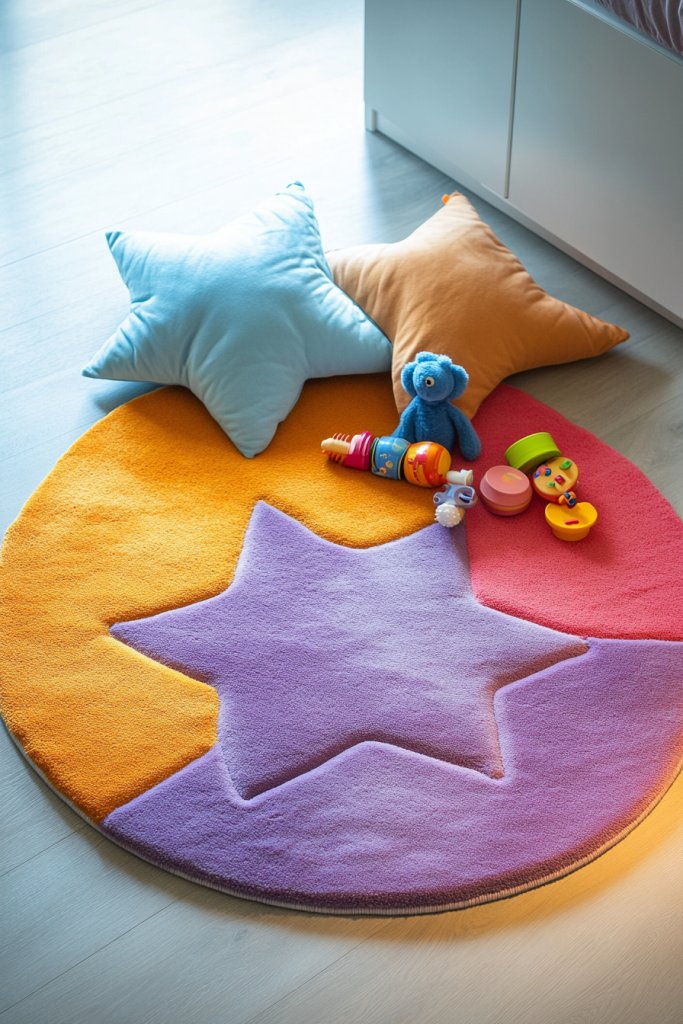
A hard floor or a cluttered space makes it difficult for kids to feel comfortable during play or rest. Parents want a designated zone that’s soft, inviting, and clearly defined. An area rug creates a visual boundary, making the room feel more organized and cozy. But how do you choose the right rug for maximum comfort and style?
Picture a bright, plush rug in the shape of a cloud, star, or animal, placed centrally in the room. The soft textures invite kids to crawl, sit, or lie down comfortably. The colors are vibrant but coordinated with the room’s theme, adding a playful touch. Surrounding the rug are cushions and toys, making it an instant retreat for reading, playing, or relaxing.
Choose rugs in fun shapes and textures to match different room themes—geometric patterns, fluffy faux fur, or woven jute for a natural look. Use layered rugs for added dimension and comfort, especially in colder climates. For easy cleaning, opt for machine-washable materials or rugs with removable covers. Seasonal accents like cozy throws or themed cushions can change the vibe throughout the year.
Pick a soft, durable rug in a size that defines the play area without overwhelming the room. Anchor it with non-slip backing or add grip pads underneath. Position cushions and toys on the rug to create a cozy zone. Keep it clean by vacuuming regularly and spot-cleaning stains promptly. Rotate or replace the rug periodically to maintain freshness and hygiene. Consider eco-friendly or machine-washable options for easy maintenance.
Personalize the rug with embroidered initials or applique patches that reflect your child’s interests. Add decorative pillows or plush toys that coordinate with the rug’s theme. Incorporate fairy lights or string garlands around the perimeter for extra charm. Let your child pick the shape or pattern to make it truly theirs.
A dedicated rug zone makes playtime feel special and encourages imaginative adventures. It creates a clear space for both fun and relaxation, fostering a balanced routine. When the area looks inviting, kids will want to spend more time there, building confidence in their independence and creativity.
11. Personalized Name Wall Decals and Monogram Art
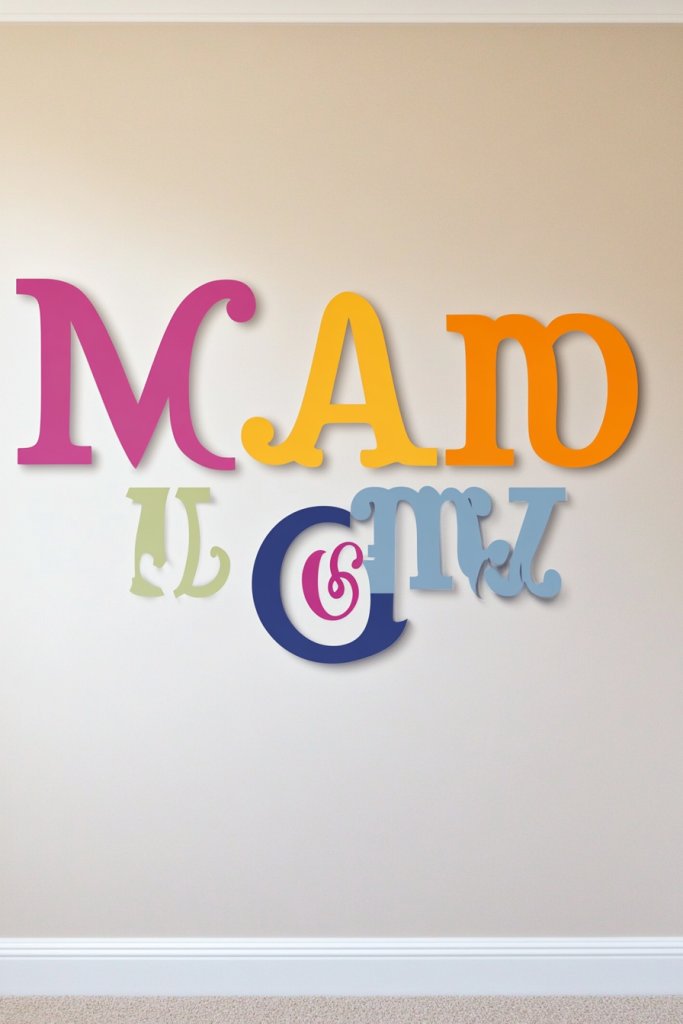
Kids love seeing their names everywhere, but generic decor can feel impersonal. Parents want to create a space that celebrates their child’s identity while adding a stylish touch. Personalized wall decals and monogram art do just that—making the room feel uniquely theirs. But how do you do it without clutter or cheesy designs?
Envision large, eye-catching decals spelling out your child’s name in a playful font, placed prominently on the wall. Monograms with intricate patterns or initials are framed with decorative borders or surrounded by themed motifs like stars or hearts. The decals are made of removable vinyl, so they peel on and off easily, leaving no residue. The overall effect is sophisticated yet fun, instantly elevating the room’s personality.
Choose from various font styles, colors, and sizes to match your decor scheme. Incorporate thematic elements—like nautical stripes, floral patterns, or geometric shapes—around the name or initials. For a minimalist look, opt for sleek monochrome decals, or go bold with metallic or glitter finishes for extra sparkle. You can also add smaller monogram accents on furniture or accessories for consistency.
Select high-quality, removable vinyl decals or framed monogram art. Carefully measure the space to ensure proper placement. Clean the wall surface thoroughly before applying decals. Use a level or stencil to align the letters perfectly, smoothing out bubbles as you go. For framed monogram art, hang using appropriate hooks or adhesive strips. Regularly check that decals remain securely attached and reposition as needed.
Encourage your child to help choose fonts, colors, or themes that reflect their personality. Add decorative elements like sparkles, metallic accents, or textured borders for extra flair. Incorporate their favorite hobbies or symbols nearby, creating a cohesive look. These personalized touches make the space feel truly special and foster a sense of ownership.
Personalized decor boosts your child’s pride and sense of identity. It makes their room feel welcoming and unique, encouraging them to spend more time in their space. These simple touches also teach them about self-expression and individuality—valuable lessons that last a lifetime.
12. Easy-Clean, Durable Paint Colors with Accent Walls
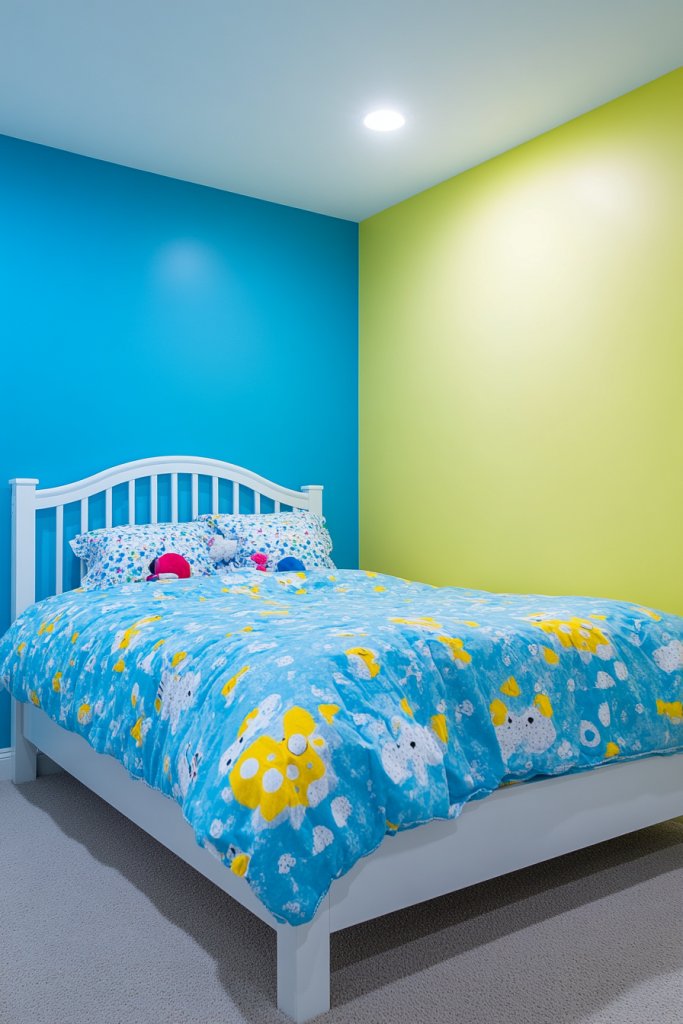
Kids can be messy, and walls often suffer from stains, scribbles, and smudges. Parents want a paint solution that’s resistant to wear and tear but also fun and lively. A durable, easy-to-clean paint can save time and frustration while keeping the room looking fresh. But how do you choose colors that are both practical and appealing?
Imagine a room painted in a cheerful pastel or vibrant hue, with one wall serving as an accent in a contrasting shade. The finish is semi-matte or satin, which hides imperfections but is still easy to wipe clean. Kids’ artwork can be displayed on the accent wall, adding personality without damaging the paint. The overall look is bright, inviting, and built to withstand daily adventures.
Opt for washable, stain-resistant paints in playful shades like aqua, yellow, or coral. Use accent walls to create focal points, such as behind a bed or desk. For a more sophisticated look, combine neutral tones with bold accent colors that can be updated easily over time. Seasonal color changes are simple with repainting or adding removable wallpapers for variety.
Start with a high-quality, washable paint suitable for kids’ rooms, preferably with low VOCs for safety. Prepare the wall by cleaning and sanding rough spots. Use painter’s tape to define the accent wall’s borders for clean lines. Apply at least two coats for durability, allowing proper drying time. For easy maintenance, choose paints with stain resistance and a smooth finish. Repainting is straightforward, and touch-ups can be done with minimal fuss.
Incorporate wall decals or removable wallpaper on the accent wall to add pattern or texture without permanent commitment. Let your kid choose colors or themes that reflect their personality. Use paint in different finishes—matte, satin, or semi-gloss—to add depth and interest. Add decorative borders or stencils for special designs or patterns.
A well-chosen, durable paint scheme creates a cheerful environment that lasts. It shows your child that their space is both fun and functional, boosting their pride. Easy-to-clean walls mean less stress for parents and more time for play. A vibrant, resilient room inspires confidence and creativity every day.
13. Modular Storage Cubes for Flexible Organization
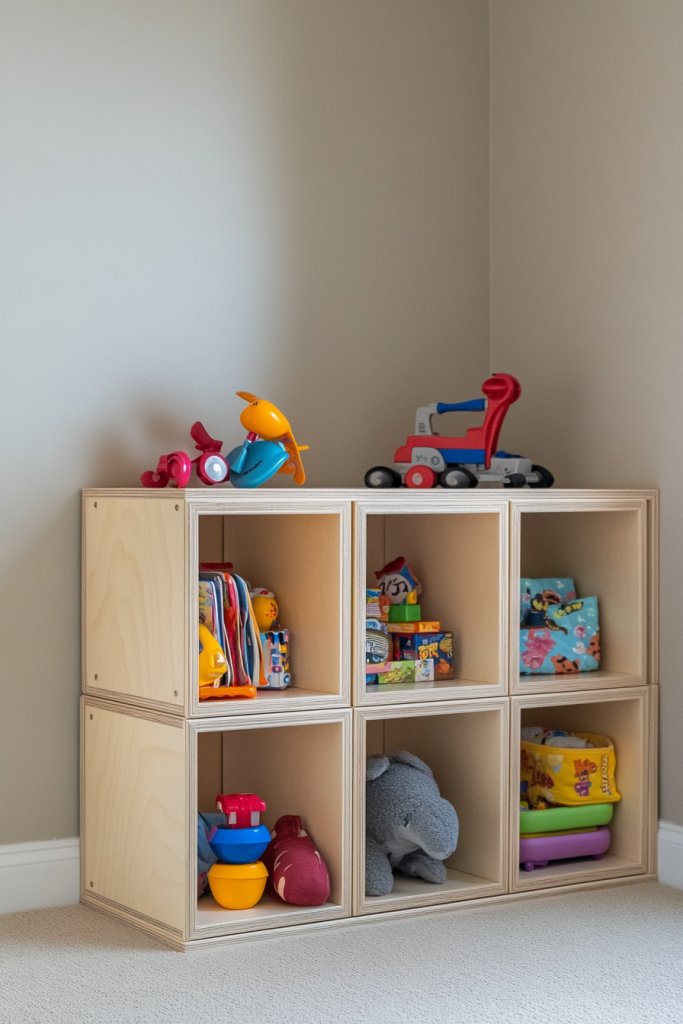
Clutter keeps piling up, and traditional storage solutions often don’t adapt to a growing collection of toys and books. Parents want versatile storage that can evolve with their child’s needs. Modular cubes offer a customizable way to keep things tidy without sacrificing style. But how do you choose and arrange the right system?
Picture a stack of colorful cubes arranged neatly in a grid against the wall or under a window. Each cube is filled with different items—art supplies, stuffed animals, or puzzles—organized by type. The flexible nature allows you to add or remove units as needed. The bright colors and simple design make the storage both functional and playful, blending seamlessly into the room’s decor.
Mix and match cube colors and sizes to suit your style, from pastel palettes to bold primaries. Incorporate open cubes for easy access or closed units with doors for a cleaner look. Use labels or decorative stickers to identify contents, especially as your kid’s collection grows. Arrange the cubes in different configurations—stacked, side-by-side, or in a corner—to optimize space.
Start by selecting sturdy, stackable cubes made of plastic, wood, or fabric-covered materials. Measure your space and plan the arrangement to maximize accessibility. Secure the cubes together with clips or connectors if needed for stability. Assign each cube a specific purpose: arts, toys, or books, and teach your child how to put things away. Regularly review and rotate contents to keep the system functional and fun.
Decorate the cubes with your child’s favorite colors or themes—like superheroes or animals. Use removable stickers or fabric covers for a personalized touch. Incorporate small display accessories like framed photos or decorative items on top of the cubes. Let your child help design the layout, fostering ownership and responsibility.
Modular cubes make organization a flexible and creative activity. They teach kids about sorting and responsibility, setting habits for the future. A tidy space boosts confidence and independence, turning clutter control into a fun, achievable goal. Plus, the adaptable design grows with them, ensuring long-term usefulness.
14. Hanging Fabric Baskets for Soft Toy Storage
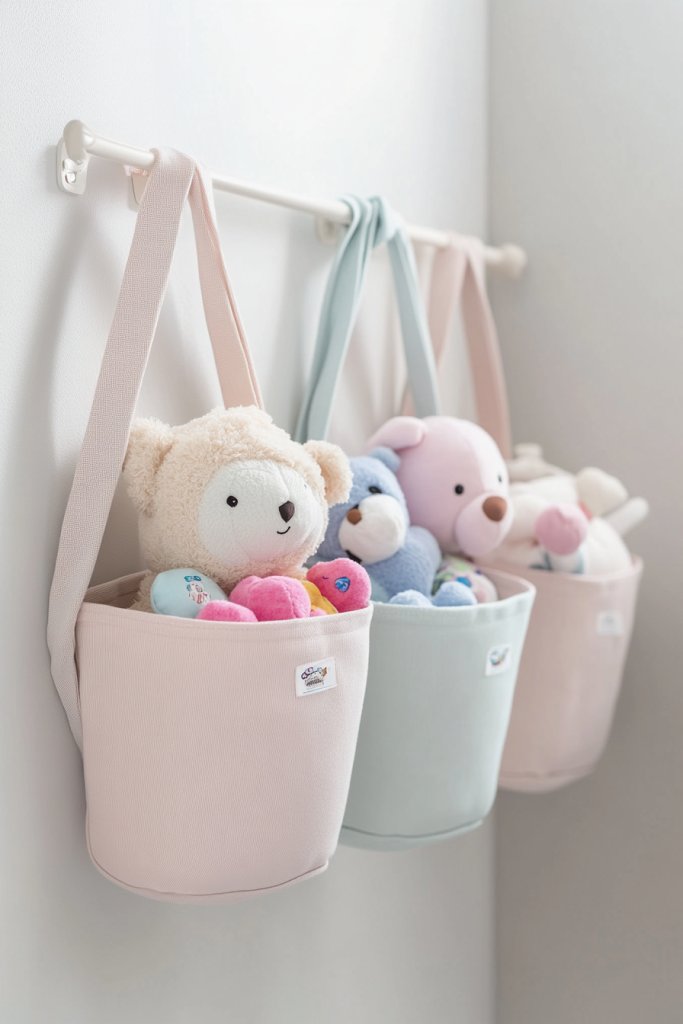
Soft toys tend to scatter all over the room, making it hard to keep surfaces tidy. Parents want a simple, stylish way to store plushies without creating clutter or sacrificing decor. Traditional bins can be bulky and unattractive, especially in smaller spaces. Hanging fabric baskets offer a soft, versatile solution that blends into the room’s aesthetic.
Imagine fabric baskets hanging from hooks or a rod behind a door, filled with cuddly stuffed animals and plush toys. The baskets are in playful patterns—polka dots, stripes, or themed prints—that add a pop of color. The toys spill over slightly, creating a cozy, inviting look. The soft fabric complements textiles in the room, making the space feel warm and welcoming.
Use different sizes and colors for a layered, eclectic look or match them for a more streamlined appearance. Hang baskets at different heights to make retrieval easier for kids of various ages. Change the fabric patterns seasonally or as interests evolve. For added fun, include personalized labels or appliqués with your child’s name or favorite characters.
Select durable, washable fabric baskets with sturdy handles or loops. Install hooks or a tension rod in a convenient location—like behind the door or along a wall. Hang the baskets securely, ensuring they can support the weight of plush toys. Teach your child to put toys in the baskets after playtime to foster tidiness. Clean the fabric regularly and replace worn-out baskets for a fresh look.
Let your child pick the fabric patterns or decorate plain baskets with fabric markers or iron-on patches. Add small decorative charms or tags to make it more personalized. Use themed fabrics—like animals, space, or fairy tales—to match the room’s decor. Encourage your child to choose which toys go in each basket, fostering responsibility.
Hanging fabric baskets make clean-up quick and easy, reducing tantrums and stress. They teach children to manage their belongings and clean up after themselves. The soft, colorful storage options make the room feel warm and inviting, encouraging play and relaxation. It’s a simple upgrade that adds both function and fun.
15. Bright, Colorful Curtains with Easy-Open Mechanisms
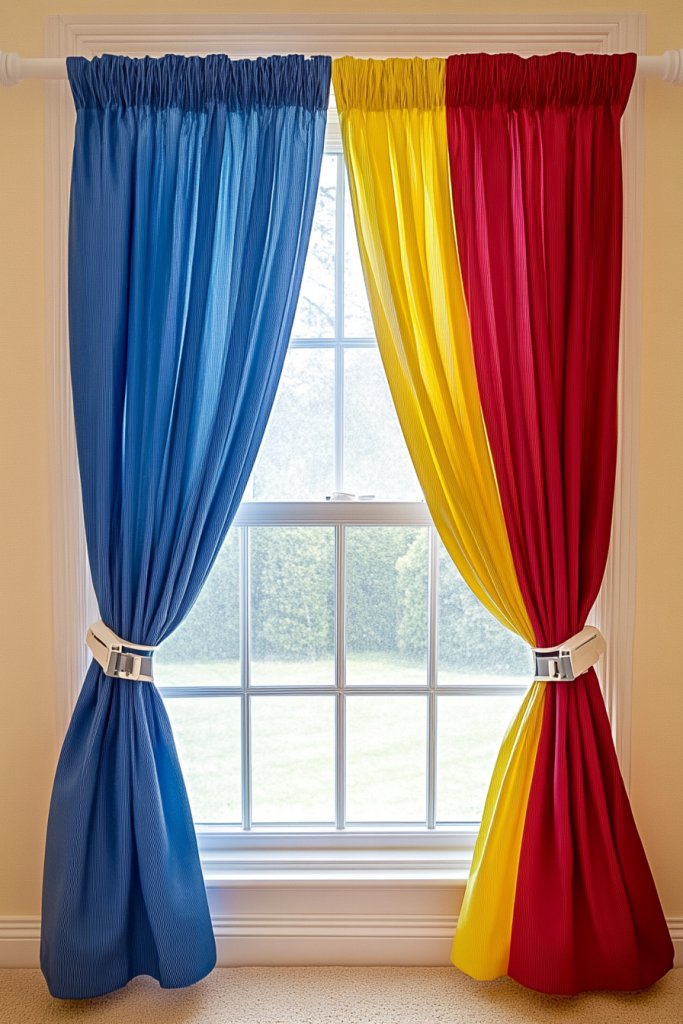
Plain, dull curtains can make a room feel flat and uninspired, and they often frustrate kids who want to control their environment. Parents seek curtains that add color and personality but are also simple enough for children to operate independently. Easy-open mechanisms make a big difference, promoting autonomy while brightening the space.
Visualize cheerful curtains in vibrant stripes or playful prints hanging from a simple rod, easily opened with child-friendly pull cords or magnetic closures. They frame a window that lets in natural light, casting colorful patterns across the room. The fabric has a soft texture, and the colors complement the room’s theme—like sunny yellows or calming blues. When open, they reveal a view or a cozy nook, making the space feel dynamic.
Choose fabrics in bold patterns, cheerful hues, or subtle pastels based on your child’s personality. For older kids, consider blackout curtains with easy-to-operate pull rings for better sleep. For a whimsical touch, add decorative tiebacks or patterned valances. Seasonal updates can be made with removable fabric panels or layered curtains for different moods.
Select lightweight, washable fabrics with reinforced edges and easy-to-grip closures. Install a sturdy, child-height curtain rod with simple brackets. Use pull cords with child-safe knots or magnetic closures that are easy to grasp. Teach your child how to operate the curtains safely and independently. Regularly wash and inspect for wear, replacing or repairing as needed. Add tiebacks or decorative clips to enhance style.
Let your child pick their favorite colors or patterns, and add decorative touches like pom-poms or tassels. Use matching or contrasting tiebacks to add flair. Incorporate themed fabrics that reflect their interests—like animals, stars, or favorite characters. Encourage them to help with measurements and installation, making it a fun, DIY project.
Bright, easy-to-open curtains give kids a sense of control and pride in their space. They promote independence and help establish routines, like bedtime or day routines. Stylish, colorful curtains transform the room into a cheerful haven, boosting mood and confidence. It’s a small change with a big impact on daily comfort.
16. DIY Craft Stations with Accessible Supplies and Storage
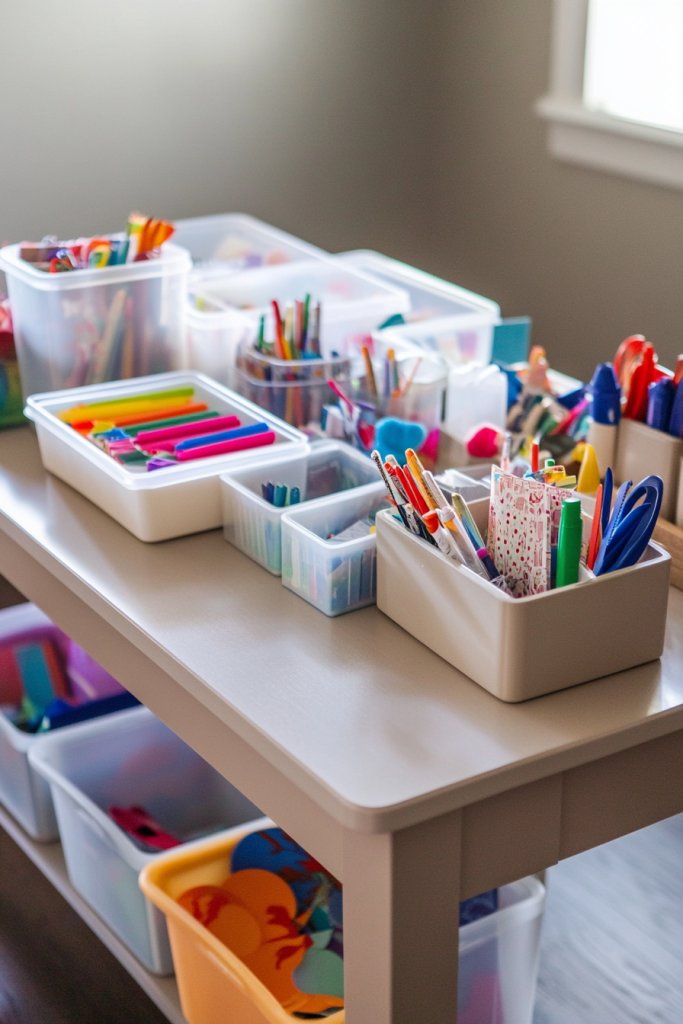
Kids love to create, but messy supplies and cluttered storage can kill the fun quickly. Parents want a dedicated craft station that’s both inspiring and organized, making cleanup easier. When supplies are easily accessible, kids are more likely to be independent and creative. But how do you set up a space that’s functional and fun?
Picture a sturdy, low table with open bins filled with markers, paints, and paper within easy reach. A pegboard above holds scissors, glue, and ribbons, all neatly arranged. The surface is clear, with a few colorful containers for ongoing projects. The space invites spontaneous creativity, with bright colors and tactile textures adding to its appeal. It’s a dedicated zone where mess is contained and inspiration flows.
Use open bins or clear containers for instant access, or add labels for older kids learning organization. Incorporate a roll-up fabric or corkboard for displaying finished projects. Adjust the height of the table for different ages, or add a fold-down surface for compact spaces. Seasonal decor, like themed tablecloths or storage accessories, keeps the area fresh and engaging.
Choose a sturdy, easy-to-clean table that fits your space. Organize supplies into accessible containers—think stackable drawers or open baskets—labeled for easy findability. Mount a pegboard or install wall-mounted racks for tools and embellishments. Teach your child to put supplies back after use, establishing good habits. Rotate or replenish supplies regularly to maintain interest and order. Consider adding a small stool or adjustable chair for comfort.
Let your child decorate their storage containers with stickers or drawings. Incorporate themed accessories—like unicorn or dinosaur motifs—that match their interests. Frame finished artwork or hang a small gallery wall nearby for inspiration. Use textured fabrics or colorful mats to define the space and make it inviting. Encourage them to help organize, fostering responsibility and pride.
A well-organized craft station stimulates creativity and independence. It teaches kids how to manage supplies and clean up after themselves. A dedicated creative space boosts confidence and self-expression. Plus, it makes crafting more enjoyable and less stressful for everyone involved.
17. Light-Filtering Window Shades for Comfort and Privacy
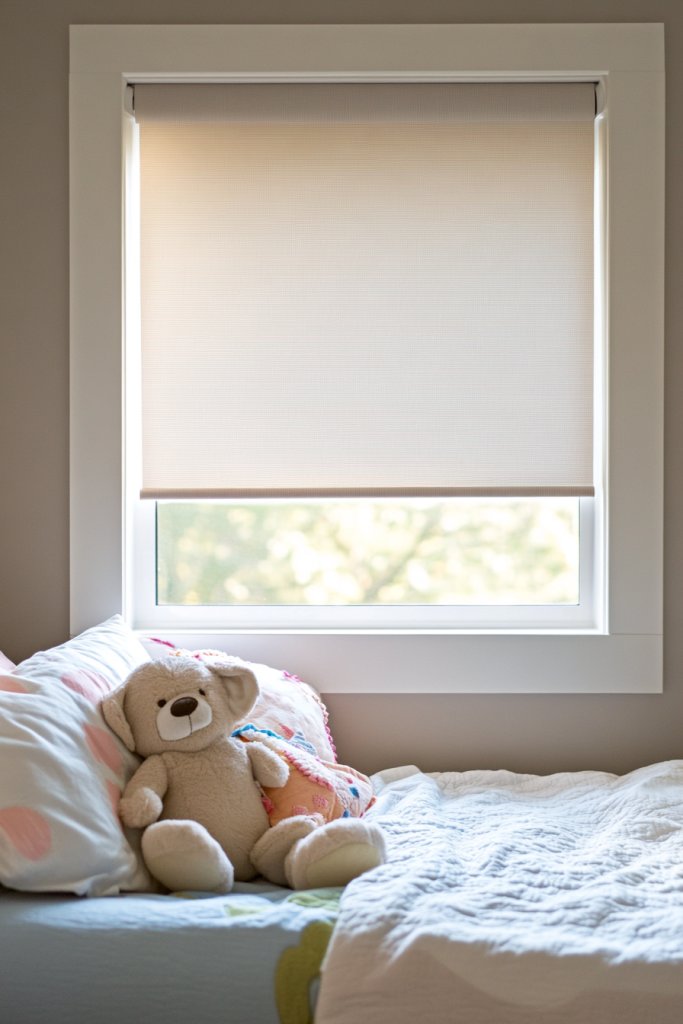
Bright sunlight or harsh glare can make a child’s room uncomfortable and disruptive. At the same time, privacy is essential for restful sleep and personal space. Parents seek window shades that balance light control with style, offering privacy without making the room feel dark or gloomy. But finding the right solution can be overwhelming.
Imagine sleek, fabric shades in cheerful colors or fun patterns that gently filter sunlight, creating a soft glow. When closed, they block out glare and provide privacy; when open, they let in natural light that brightens the room. The shades glide smoothly along the rod, operated easily by a child-friendly cord or pull mechanism. The fabric’s pattern complements the room decor, adding a decorative touch.
Choose from a variety of fabrics—sheer, blackout, or layered styles—to suit different needs. For a playful look, select shades with prints or bright hues; for a more subdued aesthetic, opt for neutral tones. Consider cordless or motorized options for added safety and convenience. Install the shades at a height that’s easy for your child to operate, fostering independence.
Measure window dimensions carefully to select the right shade size. Mount the brackets securely, ensuring smooth operation. Choose a fabric that resists fading and is easy to wipe clean. Teach your child how to open and close the shades safely, emphasizing gentle handling. Regularly dust or clean the shades with a damp cloth to keep them looking fresh. Consider layering with blackout curtains for complete darkness when needed.
Let your child choose fabric patterns and colors to match their personality or room theme. Add decorative trims or tiebacks for extra style. Use themed or textured fabrics—like faux linen or printed patterns—that reflect their interests. Encourage them to help with installation to develop a sense of ownership. These shades become a functional and fun part of their daily routine.
Proper window coverings improve sleep quality and create a calm environment, helping children feel secure. Giving them control over light and privacy fosters independence and responsibility. A stylish, functional shade elevates the room’s design while supporting daily routines. It’s a practical upgrade that nurtures comfort, confidence, and a good night’s sleep.
Conclusion
Exploring these kids’ room ideas showcases a variety of creative and practical ways to transform a space into a joyful haven. Whether you choose bold themes, clever storage, or cozy corners, each idea can be tailored to fit your child’s personality and your home’s style. Don’t hesitate to try out these ideas and make your child’s room a place where dreams and adventures come to life. Your perfect kids’ room is just an idea away—start creating today!